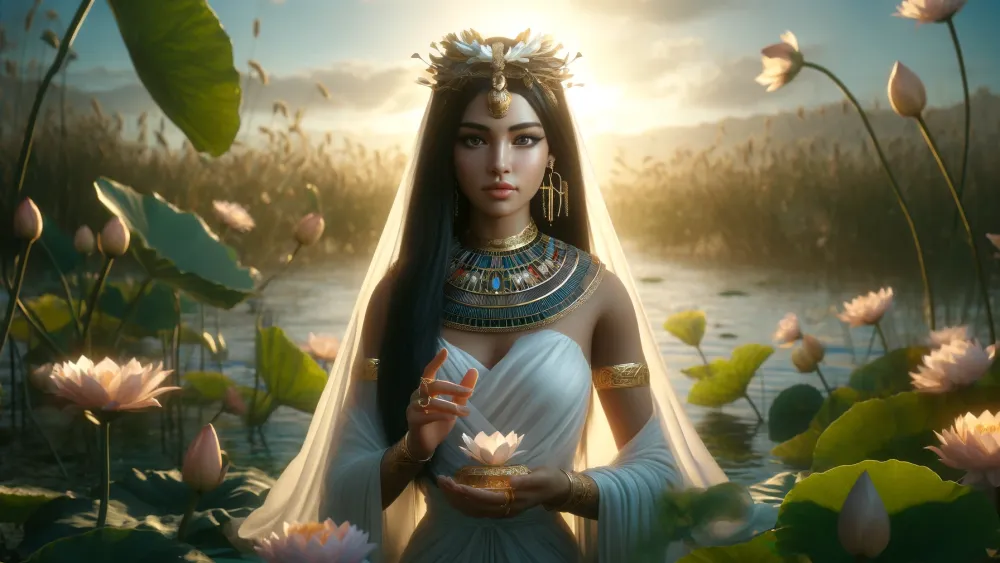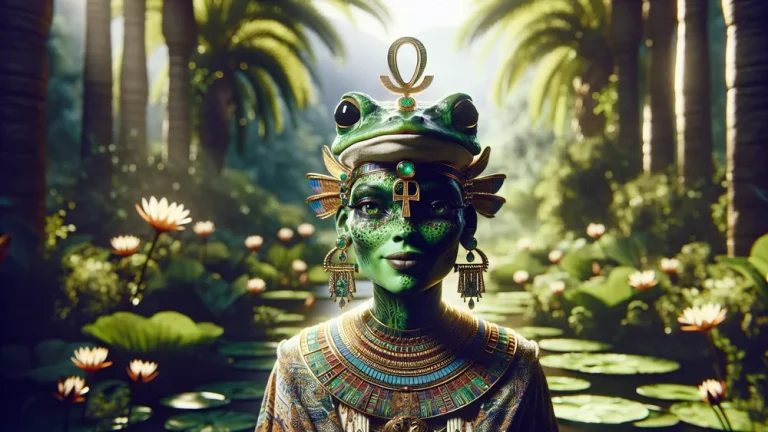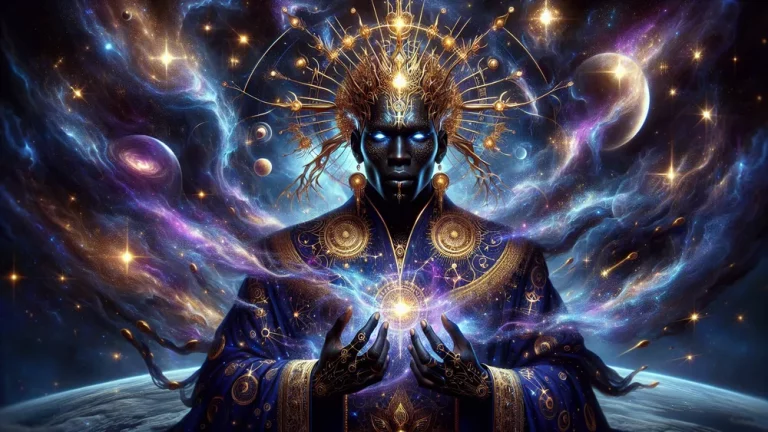Kebechet: Ancient Egyptian Goddess Of Freshness
In the big, colorful world of old Egyptian stories, Kebechet is a pretty cool character. She’s the goddess who keeps things fresh and clean, and she was super important to the people back then. This blog post is going to look at where she came from, why she mattered, and why people still talk about her today.
Key Points:
- Kebechet is the Ancient Egyptian goddess of freshness and cleanliness.
- She is the daughter of Anubis and is linked with water and the mummification process.
- Kebechet provided pure water for cleansing in mummification and the afterlife.
- She is often represented as a snake or a woman with a snake’s head.
- Kebechet was worshipped in temples like Abydos and Saqqara with offerings of water and incense.
- In modern times, Kebechet is still admired in neopaganism and appears in books, movies, and video games.
We’ll check out her background in myths, old writings, and stuff like that. Plus, we’ll see how she helped with mummies and what she looked like in old art. We’ll also talk about the rituals and offerings people did for her, and how she’s still around in modern times and in movies and books. So, let’s dive in and learn all about Kebechet, the goddess who kept things fresh in ancient Egypt.
Kebechet: Overview and Key Facts
| Aspect | Details |
|---|---|
| Name | Kebechet (also called Qebehet or Kebehut) |
| Role | Goddess of keeping things fresh and clean |
| Parentage | Daughter of Anubis (the mummy god) and maybe Anput or Nephthys |
| Symbolism | Linked with water, cleaning, and the mummy-making process |
| Depictions | Shown as a snake or a woman with a snake’s head |
| Mythological Role | Helped with mummies and gave cool water to dead folks |
| Historical References | Found in Pyramid Texts, Coffin Texts, and lots of funeral writings |
| Worship Sites | Temples for Anubis, different burial places |
| Offerings | Water, cool drinks, and other cleaning stuff |
| Modern Relevance | Sometimes mentioned in neopagan stuff and in movies and books |
| Significance | Made sure dead people stayed clean and fresh in the afterlife |
The Origins of Kebechet
To really get Kebechet, we gotta look at where she came from and the tales that made her who she is. Let’s dig into her beginnings and see how she fit into the big, wild world of ancient Egyptian stories.
Mythological Background
Kebechet, in the big, wild world of ancient Egyptian myths, is like the ultimate cleaner-upper. Imagine her as the one who keeps everything fresh and tidy. She’s the daughter of Anubis, the mummy god, and maybe Anput or Nephthys. Think of Anubis as the boss of a huge cleaning crew, and Kebechet is his go-to person, making sure everything stays spotless.
In the stories, she had a super important job. She gave cool, refreshing water to the spirits of the dead. It’s kind of like how you might hand a glass of water to a friend who’s been working hard all day. This job made her essential in the afterlife, ensuring that the dead were clean and comfy. It’s like she was the ultimate spa attendant for souls, always there to refresh and cleanse.

Historical References
When you dig into the old Egyptian texts and artifacts, Kebechet shows up in some pretty cool spots. For instance, the Pyramid Texts and Coffin Texts, which are like ancient Egyptian how-to guides for the afterlife, mention her a lot. These texts show she was super important in mummification.

Imagine finding your great-grandma’s recipe book with notes about a secret ingredient – Kebechet is that secret ingredient for the Egyptians. They also found her name and pictures in tombs and on amulets, which were like ancient good luck charms.
These artifacts tell us people really valued her role in keeping things fresh and clean for the dead. I once stumbled upon an old family photo album in my attic, and it felt like finding hidden treasure. That’s what it’s like for archaeologists when they find mentions of Kebechet.
Kebechet played a crucial role in ancient Egyptian mummification, with her presence prominent in texts, tombs, and amulets, shedding light on the Egyptians’ beliefs and practices.
Kebechet’s Role in Egyptian Religion
Alright, so we’ve seen where Kebechet shows up in old texts and artifacts. Now, let’s jump into what she actually did and why she was such a big deal in Egyptian religion.
Goddess of Purification
Kebechet, as the goddess of purification, had a super important job, especially when it came to mummification and the afterlife. Imagine her as the ultimate cleaner, making sure everything was spotless for the journey to the afterlife.
In the mummification process, she provided pure, cool water to cleanse the body, which was like giving a refreshing drink to someone on a hot day. This water wasn’t just any water; it was sacred and essential for purifying the deceased. Think of it like using a special soap that not only cleans but also has a deeper, spiritual significance. In the afterlife, Kebechet’s role didn’t stop.
She continued to refresh and purify the souls of the dead, ensuring they remained clean and comfortable. It’s like she was running an eternal spa for the spirits, always there to provide that much-needed refreshment.

Kebechet, however, had the real deal, the sacred stuff that made all the difference.
Symbolism and Iconography
Kebechet is often shown as a snake or a serpent, which might sound a bit creepy, but in ancient Egypt, snakes were symbols of protection and renewal. Imagine seeing a snake and thinking, “Hey, that’s a good sign!” In some images, she appears as a woman with a snake’s head, which is pretty wild if you think about it. This combo of human and snake features shows her dual nature – both nurturing and protective.
It’s like having a superhero with two superpowers. She also sometimes carries a jar of water, symbolizing her role in purification. Think of it like a janitor’s bucket, but way more sacred and important. I once saw a painting of her in a museum, and it was fascinating to see how detailed and symbolic the art was. It made me think about how every little detail had a meaning, just like how we might wear a lucky charm or have a special keepsake. Here’s a quick table to break down some of her main symbols:
| Symbol | Representation |
|---|---|
| Snake/Serpent | Protection, renewal |
| Woman with snake head | Dual nature, nurturing and protective |
| Jar of water | Purification, sacred cleansing |
These symbols weren’t just random; they were carefully chosen to represent her powers and roles.

Worship and Rituals
Alright, so we’ve checked out Kebechet’s symbols and what they mean. Now, let’s jump into how folks actually worshipped her and the rituals they did.
Temples and Worship Sites
Kebechet had her special spots where people would go to honor her, and these places were pretty significant. One of the main temples dedicated to her was in Abydos, which was a major religious center in ancient Egypt. Imagine a bustling city where everyone is super into their gods and goddesses. People would come here to perform rituals and ceremonies, often involving water, to honor Kebechet’s role in purification. It’s like going to a spa, but with a spiritual twist.
Another key site was the temple complex at Saqqara, where she was worshipped alongside other deities involved in the afterlife. Think of it as a big family gathering, but with gods and goddesses. I remember reading about how they would pour water over statues of Kebechet as part of the rituals, which sounds kind of like how we might water plants to keep them fresh. Here’s a quick list of some key temples and sites:
- Abydos: Major religious center with rituals involving water.
- Saqqara: Temple complex where she was worshipped with other deities.
These places weren’t just buildings; they were hubs of spiritual activity and devotion.
People honored Kebechet at special temples in Abydos and Saqqara, where rituals involving water were performed to purify and worship her alongside other deities.
Offerings and Prayers
When folks wanted to show some love to Kebechet, they brought all kinds of stuff and said special prayers. Think of it like giving a gift to someone you really look up to. They often brought water, which makes sense because she was all about keeping things clean and pure. Imagine bringing a bottle of fancy water to a party, but way more meaningful.

They also gave her food, like bread and fruits, which stood for sustenance and life. It’s like how we might bring a casserole to a potluck. Incense was another common offering, and it was believed to purify the air and create a sacred space. Picture lighting a scented candle to set the mood, but on a spiritual level.
Here’s a quick list of some typical offerings:
- Water: Symbol of purification.
- Food (bread, fruits): Represents sustenance and life.
- Incense: Purifies the air and creates a sacred space.
Prayers to Kebechet were often about seeking purification and protection. People would ask her to cleanse their spirits and keep them safe, especially in the afterlife. It’s like asking for a guardian angel to watch over you.
Kebechet in Modern Culture
So, we’ve dug into how Kebechet was celebrated back in the day. But what about now? Her essence didn’t just disappear; it morphed.
Contemporary Worship
These days, Kebechet still has her admirers, especially among folks who are into neopaganism and revivalist movements. Imagine people today looking back and saying, “Hey, those ancient gods had some cool ideas!” Some modern worshippers see her as a symbol of freshness and renewal, which makes sense if you think about how we all need a little cleansing now and then.

It’s like hitting the reset button on your life. They might set up small altars at home with water, candles, and maybe some incense to honor her. Picture a cozy corner in your house dedicated to good vibes. Here’s a quick list of some modern practices:
- Neopagan altars: Small setups with water, candles, and incense.
- Rituals for renewal: Personal ceremonies to cleanse and refresh.
- Festivals and gatherings: Community events where people share their experiences and practices.

Kebechet in Popular Media
Kebechet shows up in all sorts of books, movies, and even video games these days. It’s like bumping into an old buddy in a new spot. In some stories, she’s a mystical figure who helps guide souls in the afterlife, which is pretty close to her ancient role. Think of her as a spiritual tour guide. I remember watching a movie where she was a guardian spirit, and it made me think about how these ancient myths still resonate with us.
In other media, she might be shown as a symbol of purity and renewal, which ties back to her historical significance. It’s fascinating to see how these portrayals keep her essence alive. Here’s a quick list of some places you might find her:
- Books: Often as a mystical guide or guardian.
- Movies: Sometimes depicted as a spirit of purity and renewal.
- Video games: Occasionally as a character with special powers related to cleansing or protection.

Pantheon of Egyptian Mythology
When you dive into Egyptian mythology, you find a huge mix of gods and goddesses, each with their own stories and roles. It’s like a massive family gathering but with divine beings. From Ra, the sun god, to Osiris, the god of the afterlife, and even lesser-known deities like Kebechet, each one has a part in the grand tale of ancient Egypt.
Imagine a cosmic drama with gods and goddesses. If you’re curious to explore more, check out this full list with all Egyptian gods.
FAQs
1. Who were Kebechet’s parents?
Kebechet’s parents were Anubis and Anput.
2. What animals are associated with Kebechet?
Animals associated with Kebechet include the serpent, which symbolizes her role in purification and renewal.
3. How did ancient Egyptians honor Kebechet?
Ancient Egyptians honored Kebechet by offering prayers and making specific offerings that symbolized purification and freshness.
4. What is Kebechet’s significance in the mummification process?
Kebechet’s significance in the mummification process lies in her role as the goddess of purification, ensuring the deceased’s body is cleansed and prepared for the afterlife.







